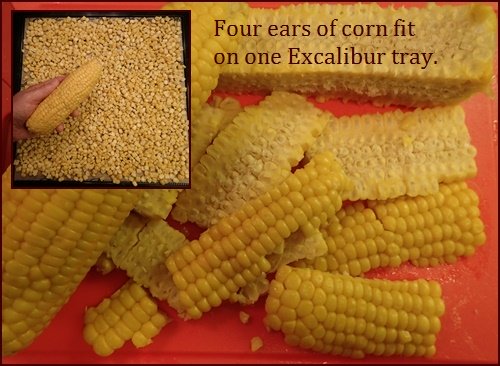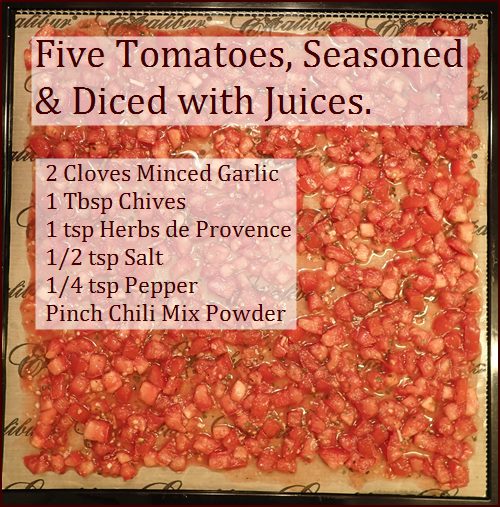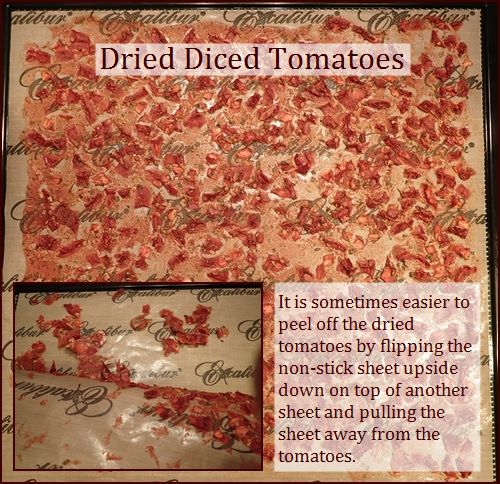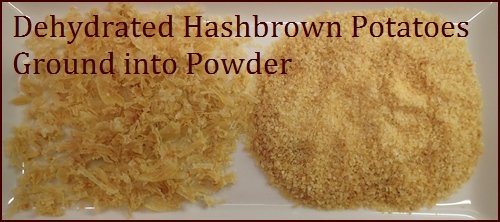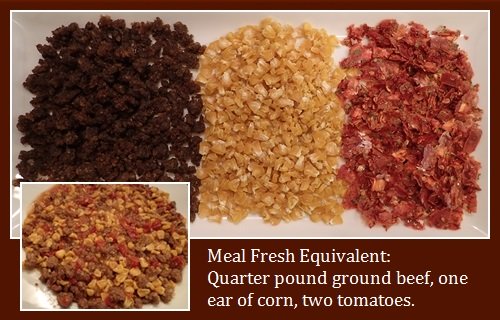| Back to Back Issues Page |
 |
|
July 2016 Trail Bytes: Dehydrating Corn on the Cob, Seasoning Tomatoes, Gluten Free Beef July 13, 2016 |
| Hello, In the June edition of Trail Bytes, I showed how to make Tomato-Carrot Soup from your summer tomato harvest. This month covers how to dehydrate another summer favorite – corn on the cob – plus more on tomatoes... how to season them before dehydrating. Lastly, I experiment with dehydrating ground beef using powdered dried potatoes instead of breadcrumbs.
Dehydrating Corn on the Cob
To dehydrate corn on the cob, cook it first. Bring a pot of unsalted water to a boil, add corn, and return to a boil for five minutes. Remove the corn and let it cool enough so you can handle it. Run a sharp knife down the cob under the kernels. You should be able to make four cuts, each with four to five rows of kernels. I did this around lunchtime, so I nibbled on what was left on the cobs. Separate the cut corn into individual kernels with your fingers and spread on a dehydrator tray with a non-stick sheet. I fit four ears of corn on one tray. Dehydrate at 125° F to 135° F for approximately twelve hours. Corn will be hard when dry with no moisture inside. Snacking Corn: Sweet corn makes a pretty good trail snack if you dry it most, but not all the way. After about eight hours of drying, check to see if the corn is mostly dry and try nibbling on a few kernels – it should be chewy with a little moisture inside. It will keep for several days in this partially dried state if you want to take a bag along on your weekend hike. Dried Yield: Four ears of corn on the cob filled 1⅓ cups and weighed 161 grams. To include one ear of corn on the cob in a meal, use ⅓ cup (dried), or 40 grams.
Seasoning Diced Tomatoes
Dried Yield: Five tomatoes filled almost one cup and weighed 38 grams. To include approximately two tomatoes in a meal, use ¼ cup (dried), or 15 grams. Store dehydrated vegetables at home in air-tight containers. If you have a FoodSaver Vacuum Sealer, I highly recommend the inexpensive wide-mouth jar sealer accessory.
Dehydrating Ground Beef Using Powdered PotatoesAs you know from the BackpackingChef page about dehydrating meat, and Recipes for Adventure, I add breadcrumbs to ground beef before cooking and dehydrating it. When you rehydrate it, the breadcrumbs help the ground beef turn out tender instead of hard like gravel.Quite a few people have asked if there is gluten-free ingredient they can use instead of breadcrumbs. What you need is a starch to combine with the meat that will enhance its ability to absorb water after it is dried. In a future newsletter, I will use dried ground rice, but since I had some dried grated potatoes on hand, we’ll start with potatoes. Learn how to dry grated potatoes here.
Dried Yield: One pound of ground beef mixed with ½ cup of potato powder filled two cups and weighed 225 grams. To include a quarter pound serving in a meal, use ½ cup (dried), or 56 grams.
How did it turn out?If you are not gluten intolerant, I recommend using dried breadcrumbs as the first choice. Breadcrumbs are convenient to use and they combine well with the ground beef. Using powdered potatoes did work – the meat was tender when I rehydrated it. The “bits” of potatoes that weren’t reduced to powder were visible in the meat and some even broke free. If you look closely at the photo above, you can see some potato bits in the meat. Since meat and potatoes go well together, the taste was good.
“Corned” Beef & Tomato RecipeWith the experiments complete, I combined the three foods into a one-pot meal. I wanted the portion to equal the quantity I might eat if the food had not been dehydrated: quarter pound of ground beef, one ear of corn on the cob, and two tomatoes.
1 Serving
On the Trail: Combine 1½ cups water with dried ingredients in pot. Let soak five minutes. Light stove, bring to boil for a minute or two. Transfer pot to insulating cozy and wait fifteen to twenty minutes. This meal can also be prepared in a Thermos Food Jar. Add the boiled water to the ingredients in the morning and eat the meal for lunch. I enjoyed this meal. The three foods added their own individual flavors and the extra seasonings in the tomatoes gave the meal a little zip. It could be made hotter with more chili powder. Another serving idea would be to roll it up in tortillas with cheddar cheese. That’s it for this month. Enjoy the rest of the summer and have fun preserving the seasonal vegetables. Dominique and I are heading to Brittany, on the coast of France, for two weeks. See you in August. I’m planning on dehydrating a pot of potato-fish stew. Happy Trails,
Chef Glenn & Dominique P.S. If you have any questions or comments about this issue of Trail Bytes, please reply to this email or use the contact form at BackpackingChef.com. Click to purchase my backpacking cookbook, Recipes for Adventure. Thank you! If you received this newsletter from a friend and would like to subscribe (it's free), subscribe here. Visit my BackpackingChef Facebook page for the lastest posts. |
| Back to Back Issues Page |
